Thermal Discomfort Levels, Building Design Concepts, and Some Heat Mitigation Strategies in Low-Income Communities of a South Asian City
Abstract
1. Introduction
2. Materials and Methods
2.1. Study Sites
2.2. Households and Housing Building Design Concepts Data
2.3. Temperature Measurements
2.4. Data Analysis
2.4.1. Discomfort Index
2.4.2. Time-Series Data
2.5. The Interviews and Survey Questionnaires
3. Results
3.1. Difference between Indoor and Outdoor Temperatures
3.2. Daily and Hourly Calculated Discomfort Indices
3.3. Mitigation Strategies
4. Discussion
5. Conclusions
Author Contributions
Funding
Institutional Review Board Statement
Informed Consent Statement
Data Availability Statement
Acknowledgments
Conflicts of Interest
References
- IPCC. Fourth Assessment Report. Geneva, Intergovernmental Panel on Climate Change; Cambridge University Press: Cambridge, UK, 2018. [Google Scholar]
- Moser, C.; Satterthwaite, D. Toward pro-poor adaptation to climate change in the urban centers of low-and middle-income countries. In Social Dimensions of Climate Change: Equity and Vulnerability in a Warming World; World Bank: Washington, DC, USA, 2010; pp. 231–258. [Google Scholar]
- Hijioka, Y.; Lin, E.; Pereira, J.; Corlett, R.; Cui, X.; Insarov, G.; Lasco, R.; Lindgren, E.; Surjan, A. Climate Change 2014: Impacts, Adaptation, and Vulnerability. Part B: Regional Aspects. Contribution of Working Group II to the Fifth Assessment Report of the Intergovernmental Panel on Climate Change; Cambridge University Press: Cambridge, UK, 2014. [Google Scholar]
- Hajat, S.; Kosatky, T. Heat-related mortality: A review and exploration of heterogeneity. J. Epidemiol. Community Health 2010, 64, 753–760. [Google Scholar] [CrossRef]
- Baccini, M.; Biggeri, A.; Accetta, G.; Kosatsky, T.; Katsouyanni, K.; Analitis, A.; Anderson, H.R.; Bisanti, L.; D’Ippoliti, D.; Danova, J.; et al. Heat effects on mortality in 15 European cities. Epidemiology 2008, 19, 711–719. [Google Scholar] [CrossRef]
- Shah, S.A.A.; Solangi, Y.A. A sustainable solution for electricity crisis in Pakistan: Opportunities, barriers, and policy implications for 100% renewable energy. Environ. Sci. Pollut. Res. 2019, 26, 29687–29703. [Google Scholar] [CrossRef]
- Oke, T.R. The energetic basis of the urban heat island. Q. J. R. Meteorol. Soc. 1982, 108, 1–24. [Google Scholar]
- Harlan, S.L.; Declet-Barreto, J.H.; Stefanov, W.L.; Petitti, D.B. Neighborhood effects on heat deaths: Social and environmental predictors of vulnerability in Maricopa County, Arizona. Environ. Health Perspect. 2013, 121, 197–204. [Google Scholar] [CrossRef]
- Smargiassi, A.; Fournier, M.; Griot, C.; Baudouin, Y.; Kosatsky, T. Prediction of the indoor temperatures of an urban area with an in-time regression mapping approach. J. Expo. Sci. Environ. Epidemiol. 2018, 18, 282–288. [Google Scholar] [CrossRef]
- Traci, L. Sustainable Climate Design. Ph.D. Dissertation, The University of Arizona, Tucson, AZ, USA, 2018. [Google Scholar]
- Alcazar, S.S.; Olivieri, F.; Neila, J. Green roofs: Experimental and analytical study of its potential for urban microclimate regulation in Mediterranean–continental climates. Urban Clim. 2016, 17, 304–317. [Google Scholar] [CrossRef]
- Sánchez, C.S.G.; Peiró, M.N.; González, F.J.N. Urban heat island and vulnerable population. The case of Madrid. In Sustainable Development and Renovation in Architecture, Urbanism and Engineering; Springer: Cham, Switzerland, 2017; pp. 3–13. [Google Scholar]
- Paul, R.K. Thermal Responses in Peri-urban Environment: A Case Study of Baduria Municipality in North Parganas, West Bengal. Observer 2018, 55, 75–83. [Google Scholar]
- Lechner, N. Heating, Cooling, Lighting. In Sustainable Design Methods for Architects, 4th ed.; John Wiley & Sons: New York, NY, USA, 2015. [Google Scholar]
- Saleem, S.G.; Ansari, T.; Ali, A.S.; Fatima, S.; Rizvi, M.H.; Samad, M.A. Risk factors for heat related deaths during the June 2015 heat wave in Karachi, Pakistan. J. Ayub Med Coll. Abbottabad 2017, 29, 320–324. [Google Scholar] [PubMed]
- Collins, M.; Knutti, R.; Arblaster, J.; Dufresne, J.-L.; Fichefet, T.; Friedlingstein, P.; Gao, X.; Gutowski, W.J.; Johns, T.; Krinner, G.; et al. Long-term climate change: Projections, commitments and irreversibility. In Climate Change 2013—The Physical Science Basis. Contribution of Working Group I to the Fifth Assessment Report of the Intergovernmental Panel on Climate Change; Stocker, T.F., Qin, D., Plattner, G.-K., Tignor, M., Allen, S.K., Boschung, J., Nauels, A., Xia, X., Bex, V., Midgley, P.M., Eds.; Cambridge University Press: Cambridge, UK; New York, NY, USA, 2013. [Google Scholar]
- Nazaroff, W.W. Four principles for achieving good indoor air quality. Indoor Air 2013, 23, 353–356. [Google Scholar] [CrossRef] [PubMed]
- Linares, C.; Díaz, J.; Negev, M.; Martínez, G.S.; Debono, R.; Paz, S. Impacts of climate change on the public health of the Mediterranean Basin population-current situation, projections, preparedness and adaptation. Environ. Res. 2020, 182, 109107. [Google Scholar] [CrossRef]
- Conti, S.; Meli, P.; Minelli, G.; Solimini, R.; Toccaceli, V.; Vichi, M.; Beltrano, C.; Perini, L. Epidemiologic study of mortality during the Summer 2003 heat wave in Italy. Environ. Res. 2005, 98, 390–399. [Google Scholar] [CrossRef]
- Gabriel, K.M.A.; Endlicher, W.R. Urban and rural mortality rates during heat waves in Berlin and Brandenburg, Germany. Environ. Pollut. 2011, 159, 2044–2050. [Google Scholar] [CrossRef]
- Okamoto-Mizuno, K.; Mizuno, K. Effects of thermal environment on sleep and circadian rhythm. J. Physiol. Anthropol. 2012, 31, 14. [Google Scholar] [CrossRef]
- Laaidi, K.; Zeghnoun, A.; Dousset, B.; Bretin, P.; Vandentorren, S.; Giraudet, E.; Beaudeau, P. The Impact of Heat Islands on Mortality in Paris during the August 2003 Heat Wave. Environ. Health Perspect. 2012, 120, 254–259. [Google Scholar] [CrossRef]
- Nicol, J.F.; Roaf, S. Rethinking thermal comfort. Build. Res. Inf. 2017, 45, 711–716. [Google Scholar] [CrossRef]
- Kingma, B.; van Marken Lichtenbelt, W. Energy consumption in buildings and female thermal demand. Nat. Clim. Chang. 2015, 5, 1054–1056. [Google Scholar] [CrossRef]
- Pallubinsky, H.; Schellen, L.; Rieswijk, T.A.; Breukel, C.M.G.A.M.; Kingma, B.R.M.; van Marken Lichtenbelt, W.D. Local cooling in a warm environment. Energy Build. 2016, 113, 15–22. [Google Scholar] [CrossRef]
- Van Marken Lichtenbelt, W.; Hanssen, M.; Pallubinsky, H.; Kingma, B.; Schellen, L. Healthy excursions outside the thermal comfort zone. Build. Res. Inf. 2017, 45, 819–827. [Google Scholar] [CrossRef]
- Schweiker, M.; Rissetto, R.; Wagner, A. Thermal expectation: Influencing factors and its effect on thermal perception. Energy Build. 2020, 210, 109729. [Google Scholar] [CrossRef]
- Masood, I.; Majid, Z.; Sohail, S.; Zia, A.; Raza, S. The deadly heat wave of Pakistan, June 2015. Int. J. Occup. Environ. Med. 2015, 6, 247–248. [Google Scholar] [CrossRef] [PubMed]
- Rhomberg, L.R.; Chandalia, J.K.; Long, C.M.; Goodman, J.E. Measurement error in environmental epidemiology and the shape of exposure-response curves. Crit. Rev. Toxicol. 2001, 41, 651–671. [Google Scholar] [CrossRef]
- Nguyen, J.L.; Schwartz, J.; Dockery, D.W. The relationship between indoor and outdoor temperature, apparent temperature, relative humidity, and absolute humidity. Indoor Air 2014, 24, 103–112. [Google Scholar] [CrossRef] [PubMed]
- Pryor, J.L.; Pryor, R.R.; Grundstein, A.; Casa, D.J. The Heat Strain of Various Athletic Surfaces: A Comparison between Observed and Modeled Wet-Bulb Globe Temperatures. J. Athl. Train. 2017, 52, 1056–1064. [Google Scholar] [CrossRef] [PubMed]
- Sohar, E.; Tennenbaum, J.; Robinson, N. A comparison of the Cumulative Discomfort Index (Cum. DI) and Cumulative Effective Temperature (Cum. ET), as obtained by meteorological data. Biometeorol. Pergamon 1962, 395–400. [Google Scholar] [CrossRef]
- Ren, Z.; Wang, X.; Chen, D. Heat stress within energy efficient dwellings in Australia. Archit. Sci. Rev. 2014, 57, 227–236. [Google Scholar] [CrossRef]
- Thom, E.C. The discomfort index. Weatherwise 1959, 12, 57–61. [Google Scholar] [CrossRef]
- Engineering ToolBox. Indoor Comfort Temperature versus Outdoor Temperature. 2006. Available online: https://www.engineeringtoolbox.com/indoor-outdoor-temperature-d_1018.html (accessed on 30 January 2021).
- Oreszczyn, T.; Ridley, I.; Hong, S.H.; Wilkinson, P.; Warm Front Study Group. Mould and winter indoor relative humidity in low income households in England. Indoor Built Environ. 2006, 15, 125–135. [Google Scholar] [CrossRef]
- Künzel, H.M. Indoor Relative Humidity in Residential Buildings—A Necessary Boundary Condition to Assess the Moisture Performance of Building Envelope Systems. 2015. Available online: https://wufi.de/literatur/K%c3%bcnzel%20-%20Indoor%20Relative%20Humidity%20in%20Residential.pdf (accessed on 3 March 2021).
- Quraishi, S.A.; Berra, L.; Nozari, A. Indoor temperature and relative humidity in hospitals: Workplace considerations during the novel coronavirus pandemic. Occup. Environ. Med. 2020, 77, 508. [Google Scholar] [CrossRef]
- Log, T. Modeling Indoor Relative Humidity and Wood Moisture Content as a Proxy for Wooden Home Fire Risk. Sensors 2019, 19, 5050. [Google Scholar] [CrossRef]
- Bylund, M.C.; Hagentoft, C.E.; Holl, K.; Nik, V.M.; Kilian, R. Simulations of moisture gradients in wood subjected to changes in relative humidity and temperature due to climate change. Geosciences 2018, 8, 378. [Google Scholar]
- Rana, R.; Kusy, B.; Jurdak, R.; Wall, J.; Hu, W. Feasibility analysis of using humidex as an indoor thermal comfort predictor. Energy Build. 2013, 64, 17–25. [Google Scholar] [CrossRef]
- Armson, D.; Stringer, P.; Ennosa, A.R. The effect of tree shade and grass on surface and globe temperatures in an urban area. Urban For. Urban Green. 2012, 11, 245–255. [Google Scholar] [CrossRef]
- Klemm, W.; Heusinkveld, B.G.; Lenzholzer, S.; Hove, B. Street greenery and its physical and psychological impact on thermal comfort. Landsc. Urban Plan. 2015, 138, 87–98. [Google Scholar] [CrossRef]
- Pathirana, S.; Rodrigo, A.; Halwatura, R. Effect of building shape, orientation, window to wall ratios and zones on energy efficiency and thermal comfort of naturally ventilated houses in tropical climate. Int. J. Energy Environ. Eng. 2019, 10, 107–120. [Google Scholar] [CrossRef]
- Makaka, G.; Meyer, E. Temperature stability of traditional and low-cost modern housing in the Eastern Cape, South Africa. J. Build. Phys. 2006, 30, 71–86. [Google Scholar] [CrossRef]
- Mohammad, S.; Shea, A. Performance evaluation of modern building thermal envelope designs in the semi-arid continental climate of Tehran. Buildings 2013, 3, 674–688. [Google Scholar] [CrossRef]
- Astrom, C. Commentary: What measure of temperature is the best predictor of mortality? Environ. Res. 2012, 118, 149–151. [Google Scholar]
- Givoni, B. Man, Climate and Architecture, 2nd ed.; Applied Science Publishers: London, UK, 1976; pp. 1–144. [Google Scholar]
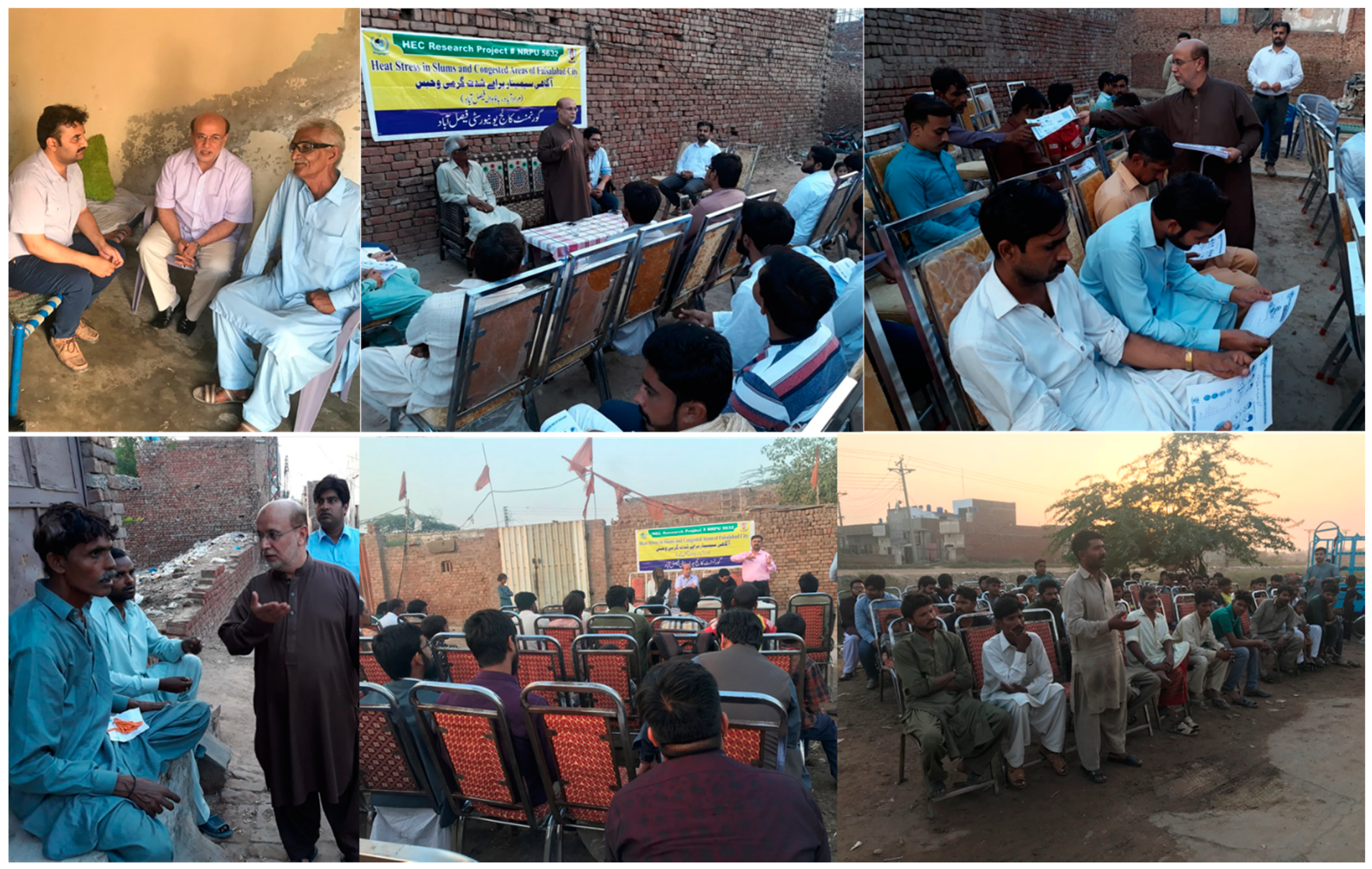
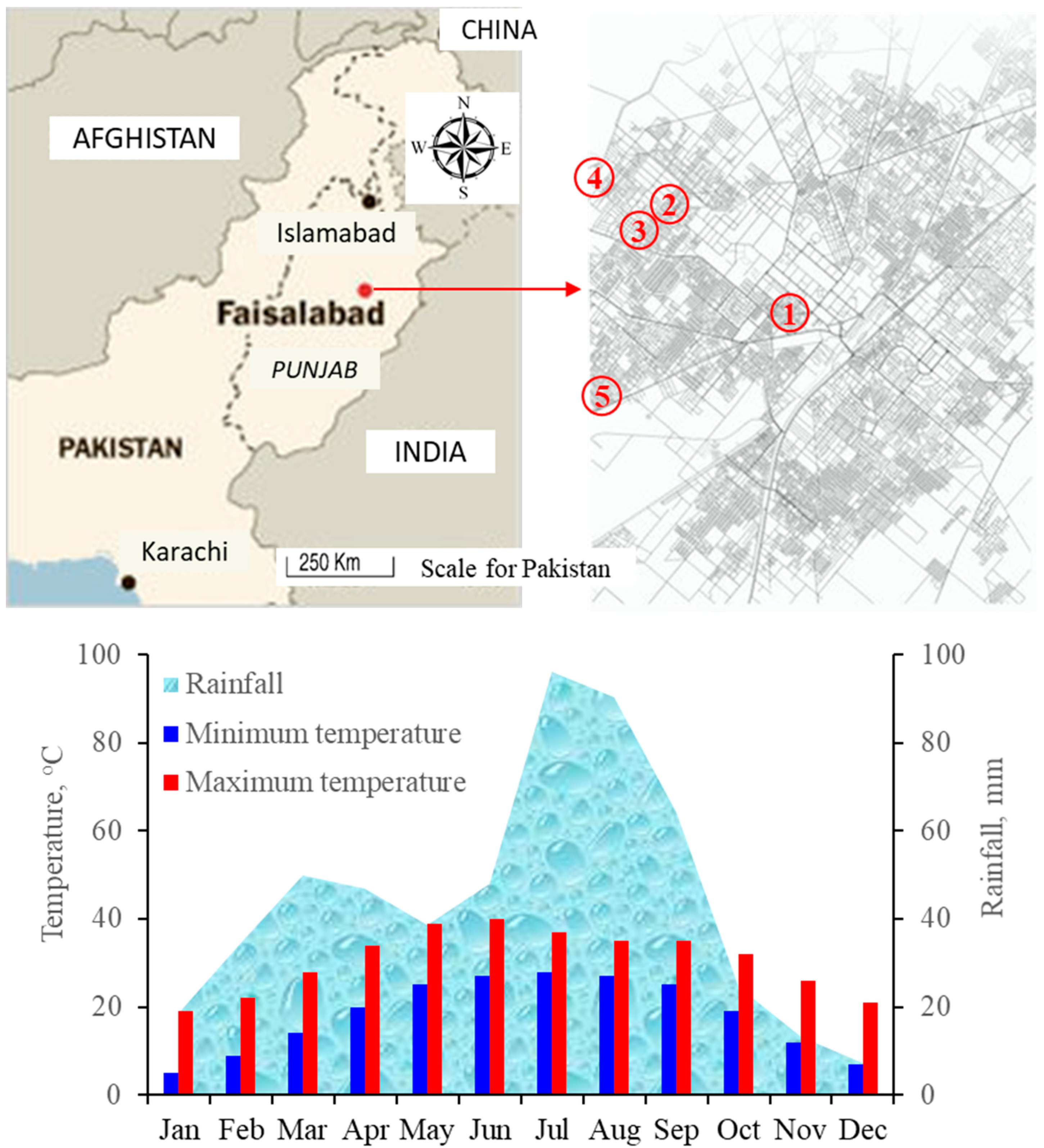
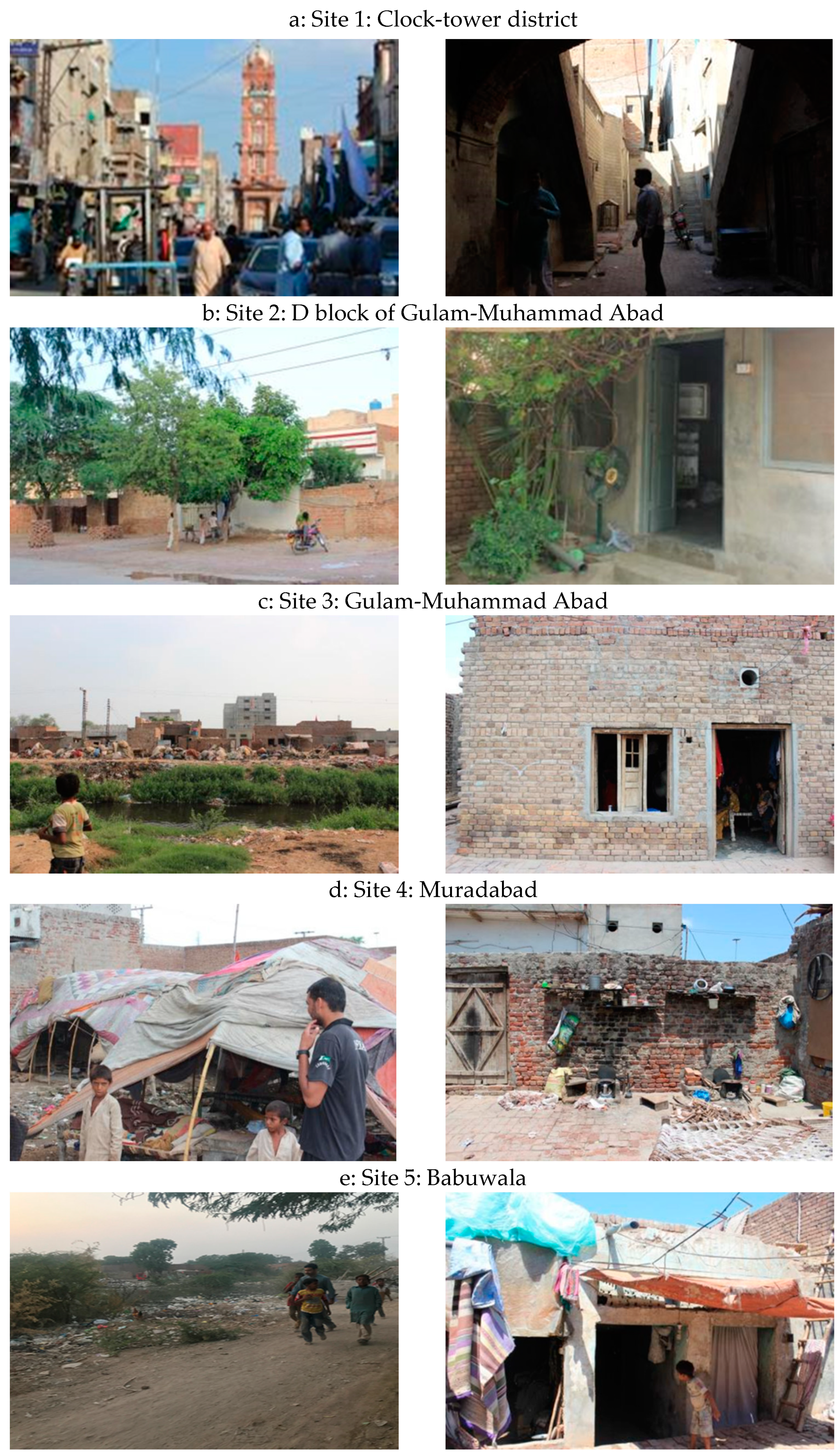

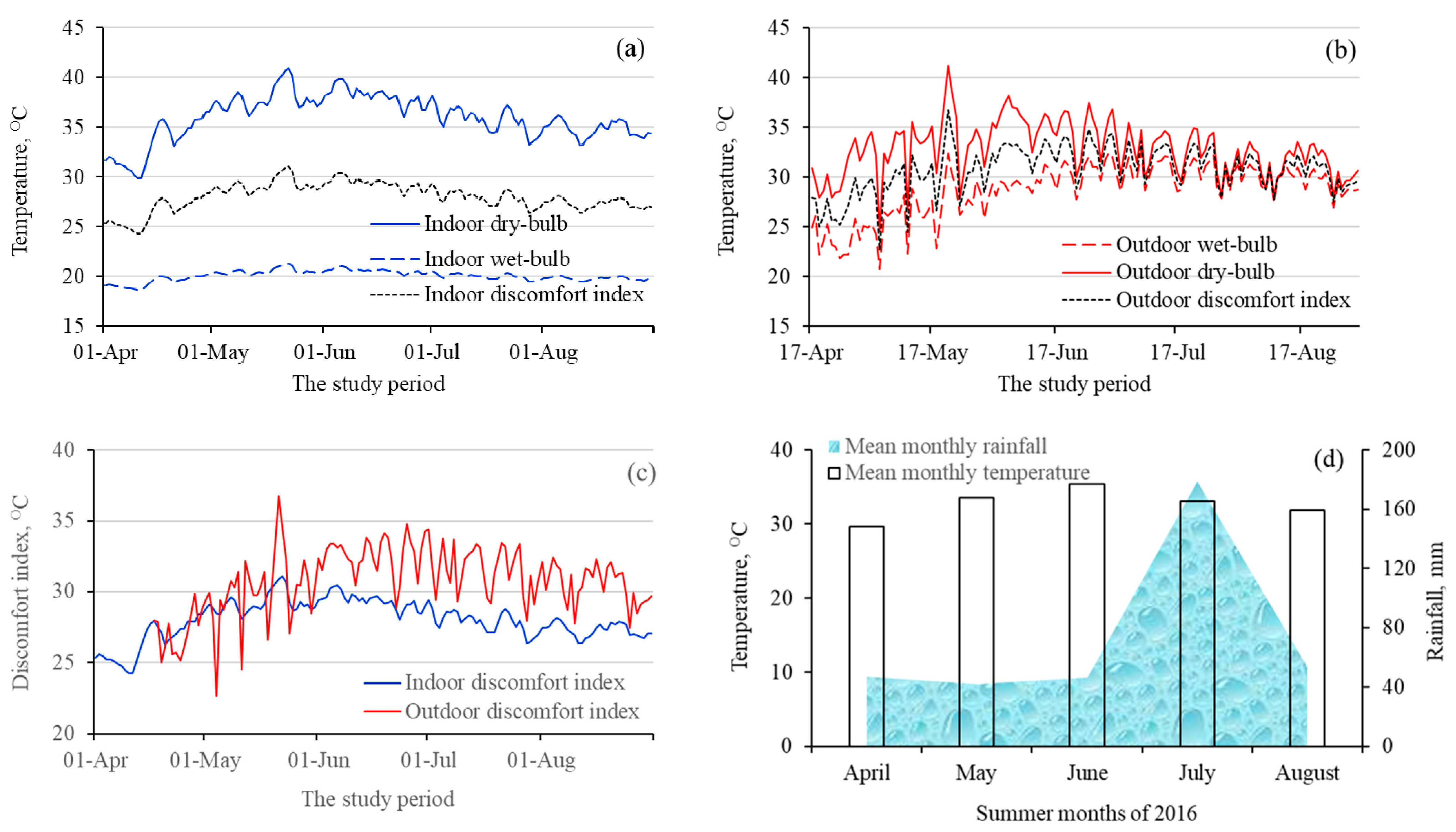
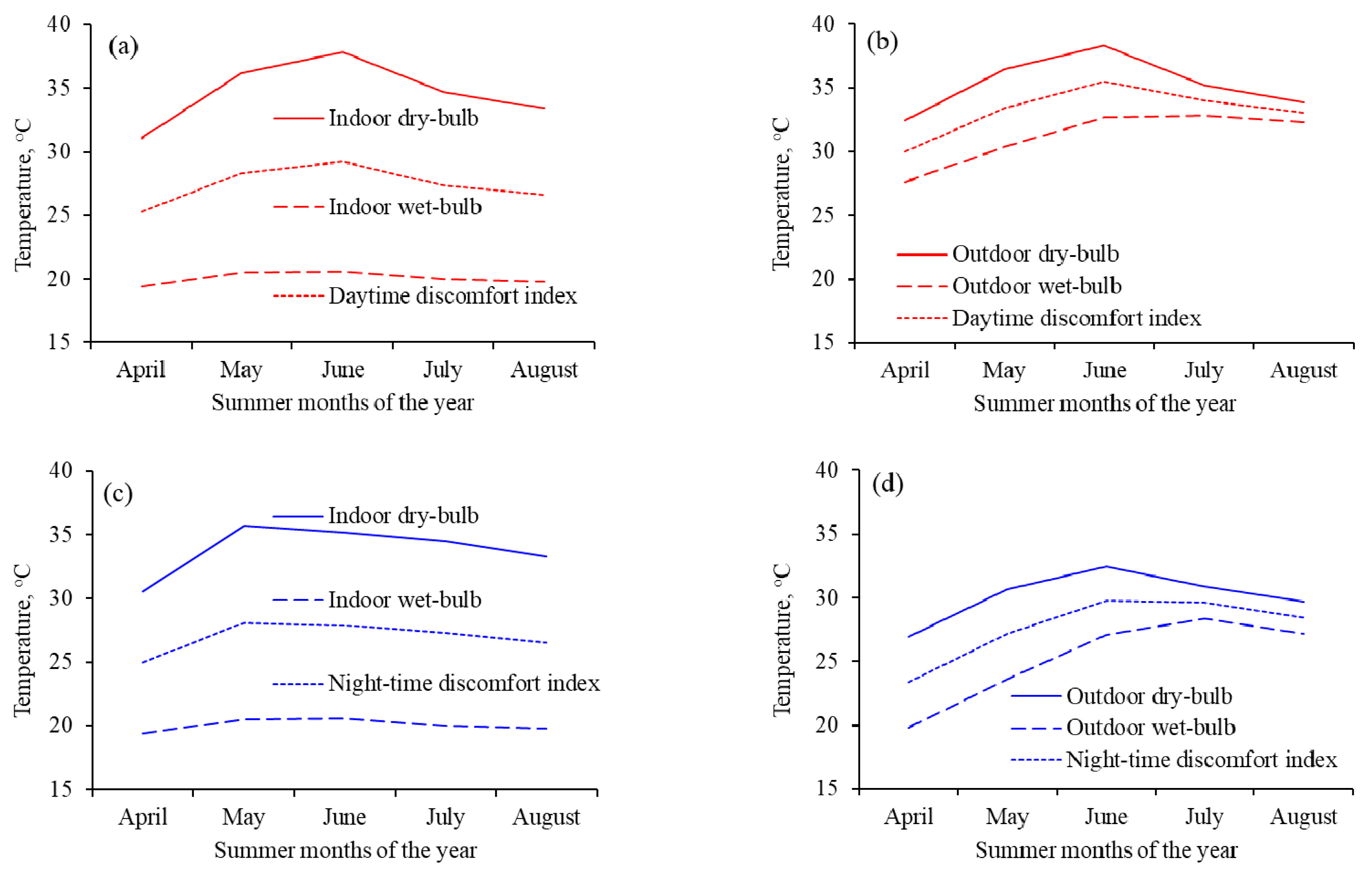
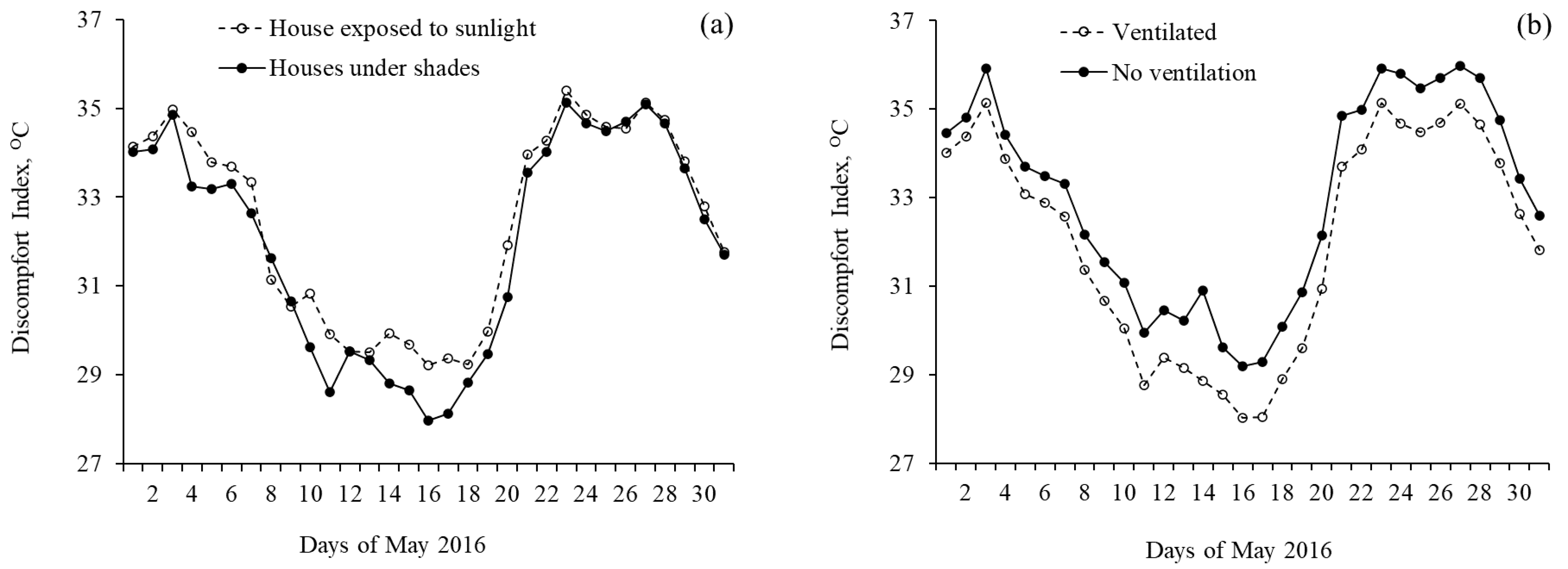

| Category | Households and Building Design | Statistics |
|---|---|---|
| Household ratios | ||
| Family size | Number of dwellers | 6.6/house |
| Gender proportion | Female:Male | ~1.0 (148:144) |
| Crowding per household | No rooms/No of occupants | 0.4 (114/292) |
| Building design concepts | ||
| Rooms with windows | With | 61% |
| Without | 38% | |
| One window | 57% | |
| Two windows | 4% | |
| Rooms with vents | With | 50% |
| Without | 50% | |
| One vent | 32% | |
| Two or more vents | 18% | |
| Rooms with shades | With | 89% |
| Without | 11% | |
| Fully shaded | 59% | |
| Partly shaded | 30% | |
| Necessities | ||
| Home appliances | Evaporative water cooler | 9.6% |
| Fan | 100% | |
| Fridge | 55% | |
| UPS/Generator | 10% | |
| Own toilet | 87% | |
| Separate indoor kitchen | 66% | |
| Washing machine | 53% | |
| Experience power outage | 100% | |
| Date dd/mm | a. Discomfort Index from Measured Td and Tw, °C | b. Discomfort Index from Engineering TooBox Equation [35], °C | c. Discomfort Index from Measured Outdoor Td-Tw Relation, °C |
|---|---|---|---|
| 01/04 | 28.2 | 25.4 | 29.9 |
| 16/04 | 28.2 | 25.2 | 29.7 |
| 01/05 | 31.5 | 28.8 | 34.2 |
| 16/05 | 29.2 | 28.8 | 29.7 |
| 01/06 | 31.7 | 29.4 | 34.9 |
| 16/06 | 32.1 | 29.6 | 35.2 |
| 01/07 | 31.6 | 29.4 | 34.9 |
| 16/07 | 30.3 | 27.6 | 32.6 |
| 01/08 | 30.9 | 27.5 | 32.5 |
| 15/08 | 30.2 | 27.0 | 32.0 |
| Minimum, °C | 28.2 | 25.2 | 29.7 |
| Maximum, °C | 32.1 | 29.6 | 35.2 |
| Mean, °C | 30.4 | 27.9 | 32.6 |
| SD, °C | 1.44 | 1.63 | 2.24 |
| Gender | Adult: ≥18 Years Old (% of Total Participants) | Non-Adult: <18 Years Old (% of Total Participants) | Total Participants (%) |
|---|---|---|---|
| Female | 85 (30.1%) | 63 (21.6%) | 148 (50.7%) |
| Male | 76 (26.0%) | 68 (23.3%) | 144 (49.3%) |
| Total | 161 (55.1%) | 131 (44.9%) | 292 (100%) |
| Health Complaints | Percent | Heat Mitigation Strategies | Percent | ||||
|---|---|---|---|---|---|---|---|
| Male | Female | All * | Male | Female | Total | ||
| Dehydration | 16.98 | 14.89 | 15.9 | Drank more water | 21.28 | 13.21 | 17.25 |
| Diarrhea | 26.42 | 17.02 | 21.7 | Drank water and took a shower | 14.89 | 5.66 | 10.28 |
| Eye infection | — | 4.26 | 2.13 | Drank water and rested | 14.89 | 9.43 | 12.16 |
| Fever | 24.53 | 23.4 | 24.0 | Moved to cooler places | 10.64 | 18.87 | 14.8 |
| Flu (runny nose) | 1.89 | 6.38 | 4.14 | Took more than usual rest | 10.64 | 7.55 | 9.10 |
| Headache | 16.98 | 27.66 | 22.3 | Took multiple showers a day | 21.28 | 41.51 | 31.4 |
| Nosebleed | 1.89 | 6.38 | 4.14 | Took shower and stayed home | 6.38 | 3.77 | 5.08 |
| Muscular fatigue | 1.89 | — | 0.95 | Did not know what to do | — | — | — |
| Skin allergy | 5.66 | — | 2.83 | Did not know what to do | — | — | — |
| Mild temperature | 2.77 | — | 1.39 | Did not know what to do | — | — | — |
Publisher’s Note: MDPI stays neutral with regard to jurisdictional claims in published maps and institutional affiliations. |
© 2021 by the authors. Licensee MDPI, Basel, Switzerland. This article is an open access article distributed under the terms and conditions of the Creative Commons Attribution (CC BY) license (http://creativecommons.org/licenses/by/4.0/).
Share and Cite
Ehsan, S.; Abbas, F.; Ibrahim, M.; Ahmad, B.; Farooque, A.A. Thermal Discomfort Levels, Building Design Concepts, and Some Heat Mitigation Strategies in Low-Income Communities of a South Asian City. Int. J. Environ. Res. Public Health 2021, 18, 2535. https://doi.org/10.3390/ijerph18052535
Ehsan S, Abbas F, Ibrahim M, Ahmad B, Farooque AA. Thermal Discomfort Levels, Building Design Concepts, and Some Heat Mitigation Strategies in Low-Income Communities of a South Asian City. International Journal of Environmental Research and Public Health. 2021; 18(5):2535. https://doi.org/10.3390/ijerph18052535
Chicago/Turabian StyleEhsan, Sana, Farhat Abbas, Muhammad Ibrahim, Bashir Ahmad, and Aitazaz A. Farooque. 2021. "Thermal Discomfort Levels, Building Design Concepts, and Some Heat Mitigation Strategies in Low-Income Communities of a South Asian City" International Journal of Environmental Research and Public Health 18, no. 5: 2535. https://doi.org/10.3390/ijerph18052535
APA StyleEhsan, S., Abbas, F., Ibrahim, M., Ahmad, B., & Farooque, A. A. (2021). Thermal Discomfort Levels, Building Design Concepts, and Some Heat Mitigation Strategies in Low-Income Communities of a South Asian City. International Journal of Environmental Research and Public Health, 18(5), 2535. https://doi.org/10.3390/ijerph18052535









